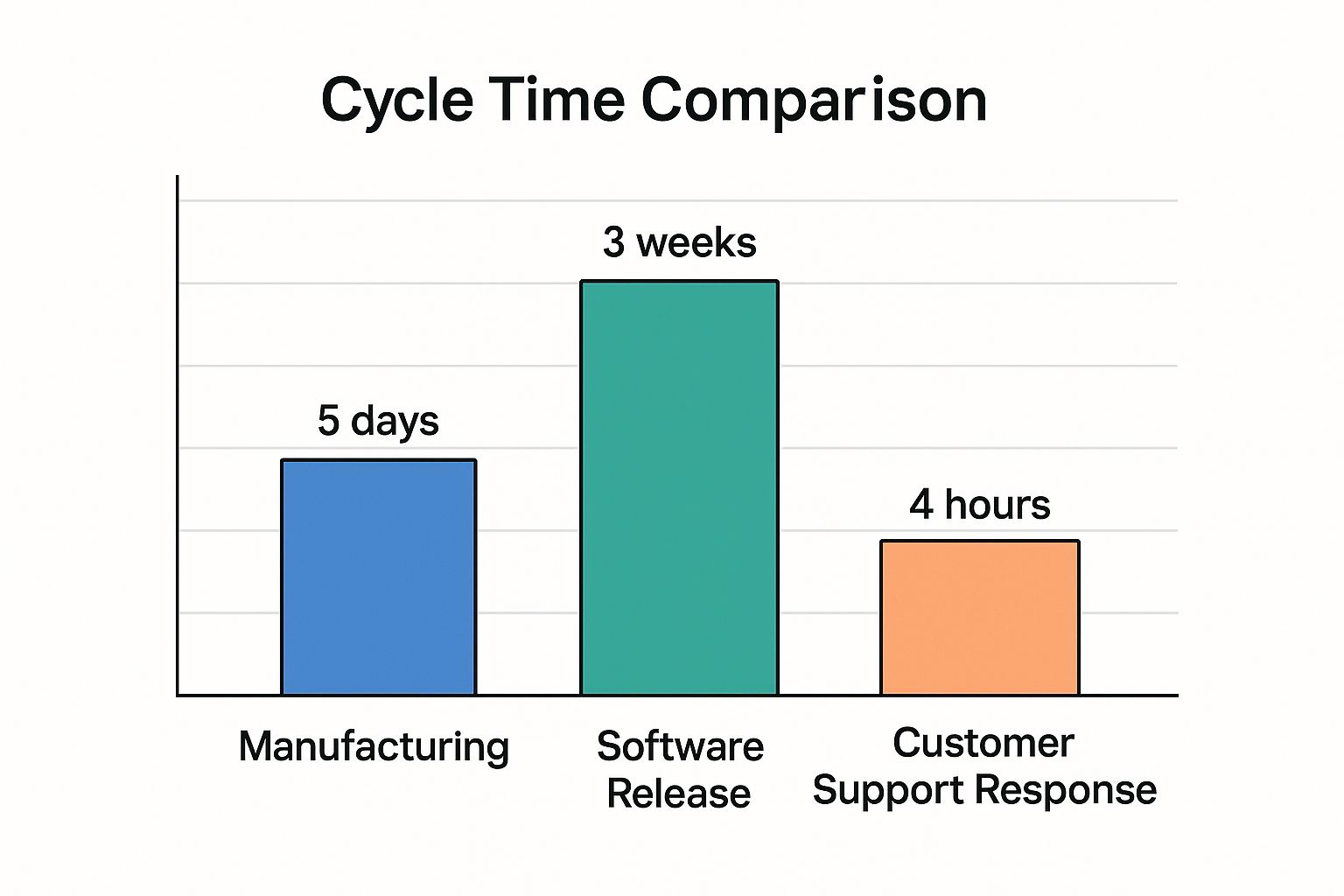Reduce Lead Time: Proven Strategies for Manufacturing Success
Learn how to reduce lead time and improve efficiency with expert strategies. Boost your supply chain performance today!
Learn the cycle time definition and how to optimize this vital metric to boost manufacturing efficiency and drive growth.

Cycle time is a fundamental metric in manufacturing, representing the total time required to complete a process from start to finish. This seemingly simple definition has profound implications for a manufacturer's success. Understanding and optimizing cycle time is crucial for achieving peak efficiency, minimizing costs, and satisfying customer demand.
A short cycle time often indicates a streamlined production process. Conversely, a long cycle time can point to bottlenecks or areas where efficiency is lagging. This is precisely why cycle time is such a vital key performance indicator (KPI) in manufacturing.
The concept of cycle time isn't new; its origins can be traced back to the beginnings of mass production. The early 20th-century automotive industry, in particular, brought cycle time into sharper focus. Henry Ford's assembly line significantly decreased the Model T's cycle time from 12.5 hours to just 93 minutes. This innovation fueled a production boom, resulting in over 15 million Model Ts manufactured by 1927. This historical example powerfully illustrates how cycle time optimization can dramatically impact output. Learn more about the evolution of cycle time in manufacturing here.
Today's manufacturing landscape is significantly more complex, and cycle times vary widely between industries. Modern automotive assembly lines average 20-30 hours per vehicle. This contrasts sharply with the time it takes to produce electronic devices like smartphones, which often falls between 30-60 minutes per unit. This difference highlights how product complexity and the level of automation influence cycle time.
Lean manufacturing methodologies, such as the Toyota Production System, continue to emphasize cycle time optimization. These systems have shown reductions of 50-70% in some processes through just-in-time workflows.
Tracking and improving cycle time remains a cornerstone of operational excellence in manufacturing today. By diligently monitoring and analyzing cycle time data, manufacturers can identify areas for improvement, optimize processes, and increase overall productivity. This, in turn, leads to enhanced profitability and strengthens a company's competitive edge. As a result, manufacturers are increasingly prioritizing cycle time as a critical metric for continuous improvement initiatives.

While the basic cycle time definition—the time it takes to complete a production process from start to finish—is simple, accurately calculating it can be more involved. Real-world manufacturing rarely operates in ideal conditions. This section explores how manufacturers go beyond the basics for a precise understanding of this key metric.
Consider a circuit board assembly line. The simple formula (Production Time / Number of Units Produced) works if the process is consistent. However, equipment malfunctions, material delays, and operator skill variations introduce variability.
This requires a more nuanced approach. Instead of a single, overall cycle time, manufacturers analyze times for individual units or batches. This pinpoints variation within the process.
Beyond simple start and end times, capturing a wider range of data points provides a more complete picture. These data points offer deeper insights into cycle time.
This granular data reveals hidden inefficiencies. Learn more in our guide on cycle time optimization.
The best calculation method depends on your operations. The data chart below visualizes a comparison of cycle time and throughput. For batch processes, the total cycle time is divided by the batch size. In continuous manufacturing, it's often calculated over a specific time interval (e.g., an hour or shift). Analyzing cycle times for individual product variants is crucial for mixed-model production.
| Calculation Method | Formula | Best For | Limitations | Accuracy Level |
|---|---|---|---|---|
| Batch Cycle Time | Total Cycle Time / Batch Size | Batch Processes | Doesn't reflect individual unit variation | Moderate |
| Continuous Cycle Time | Units Produced / Time Interval | Continuous Manufacturing | Sensitive to fluctuations in production rate | Moderate |
| Mixed-Model Cycle Time | Individual Unit Cycle Time | Mixed-Model Production | Requires detailed tracking of each variant | High |
The data chart demonstrates the inverse relationship between cycle time and throughput: as cycle time decreases, throughput increases. This highlights the importance of cycle time optimization. Learn more about calculating manufacturing cycle time.
By understanding the complexities of cycle time calculation, manufacturers gain accurate insights, allowing for data-driven decisions to optimize and improve processes. This detailed analysis identifies bottlenecks, reduces waste, and improves overall manufacturing performance.

Understanding the cycle time definition—the total time it takes to complete a production process—is crucial. But the real value lies in turning optimized cycle times into real financial gains. This section explores how leading manufacturers achieve this, converting efficiency into profit.
Reduced cycle times mean more than just faster production. They create a ripple effect of positive changes across the entire business. Shorter cycles free up resources, allowing for increased output with the same infrastructure. This directly improves cash flow as products get to market faster. Moreover, quicker production enables companies to react more quickly to changes in market demand, creating a competitive advantage. This improved market responsiveness, combined with faster order fulfillment, boosts customer satisfaction and strengthens brand loyalty. Together, these benefits create a cycle of growth and increased profitability.
Top companies go beyond simple cost savings and actively monetize their cycle time advantages. When a company delivers products faster than its competitors, premium pricing becomes a real possibility. Customers are often willing to pay more for speed. Increased output capacity and faster response times also help businesses capture a larger market share. This expansion opens up new revenue streams and strengthens the company's market position. Streamlined production, a direct result of shorter cycle times, reduces operating costs. This further boosts profit margins and strengthens the financial health of the business.
Optimizing cycle times offers significant returns, making a strong business case for investment. Studies show that even small reductions in cycle time can have a major impact on profits. Cycle time's influence on global manufacturing competitiveness is measurable. A 2020 study of 500 factories showed that a 10% reduction in cycle time led to a 5-8% increase in annual output and a 3-5% cost reduction per unit. In the aerospace industry, composite material production cycle times decreased from 40-60 hours in the 1990s to 8-12 hours by 2020, thanks to automated curing systems. The EU's Manufacturing Performance Index lists cycle time as a top-3 KPI for 78% of German industrial firms, where median cycle times decreased by 15% between 2015 and 2020 through the adoption of Industry 4.0. For more information on cycle times, check out 6Sigma. These results highlight the financial power of efficient production.
Getting executive buy-in for cycle time initiatives requires a strong business case. This means clearly showing the potential financial benefits of optimization. By demonstrating how reduced cycle times directly lead to higher profits, bigger market share, and happier customers, businesses can justify investments in technology, training, and process improvements. This connection between optimized cycle times and financial gains ensures these initiatives get the resources and support they need to succeed.
Ever wonder how your manufacturing performance measures up against the competition? This section offers real-world cycle time benchmarks across major manufacturing sectors, revealing what constitutes world-class performance in your industry. Understanding the cycle time definition and comparing your own performance is vital for process improvement.
Leading manufacturers are constantly pushing the limits of efficiency. Let's see how these benchmarks vary across different sectors:
Automotive: The automotive industry, known for its complex assembly processes, usually has cycle times between 20-30 hours per vehicle. Leading manufacturers are working to reduce these times using automation and lean principles.
Electronics: The electronics sector, especially in areas like smartphone manufacturing, achieves much shorter cycle times, often between 30-60 minutes per unit. This is largely due to higher automation levels and standardized processes.
Pharmaceuticals: This industry faces unique optimization challenges due to strict quality control and regulations. Tablet compression, for example, has tightly controlled cycle times, often between 0.2-0.5 seconds per pill, with minimal tolerance for variation.
Food Processing: Cycle times in food processing vary significantly based on product complexity and automation. Highly automated processes, like bottling, might take only a few seconds per unit, while more labor-intensive processes take considerably longer.
These examples demonstrate how product complexity, production volume, and automation significantly influence cycle time targets.
Understanding the factors that affect cycle time is essential for realistic goal-setting. This involves considering product complexity and levels of automation.
Product Complexity: More complex products with many components and assembly steps naturally have longer cycle times compared to simpler products.
Volume Requirements: High production volumes often require increased automation and optimized workflows to keep up with demand, influencing cycle time.
Automation Levels: Higher automation usually means shorter cycle times and less variation. However, the initial investment and maintenance costs of automation must be factored in.
Typical improvement rates also vary across industries. Some industries might achieve double-digit percentage improvements annually, while others experience more gradual gains. This highlights the value of industry-specific benchmarking.
To accurately assess your performance, compare your metrics against relevant industry benchmarks. This requires collecting accurate data on your own cycle times.
The following table, "Cycle Time Benchmarks By Industry," provides a starting point for understanding typical ranges and key influencing factors. This table presents typical cycle time ranges across different manufacturing sectors, showing how they've evolved over time and what factors influence them most significantly.
| Industry | Average Cycle Time | World-Class Benchmark | Key Influencing Factors | Typical Improvement Rate |
|---|---|---|---|---|
| Automotive | 20-30 hours/vehicle | <20 hours/vehicle | Automation, Lean Principles | 2-5% annually |
| Electronics | 30-60 minutes/unit | <30 minutes/unit | Automation, Process Standardization | 5-10% annually |
| Pharmaceuticals | Varies significantly | Process specific | Regulatory Requirements, Quality Control | 1-3% annually |
| Food Processing | Varies significantly | Process specific | Automation, Product Complexity | 3-7% annually |
These are examples, and actual benchmarks vary depending on specific product types and production methods. By analyzing your cycle time data and comparing it to industry benchmarks, you can identify areas for improvement and prioritize optimization efforts. This targeted approach helps you leverage cycle time reduction for a competitive edge and increased profitability.

Many companies initiate projects to reduce cycle time—the total time it takes to complete a production process. However, these initiatives often stall or fail. This section explores the common roadblocks that hinder these improvement projects and offers solutions for overcoming them. A solid grasp of the cycle time definition is essential for tackling these challenges.
The initial step in overcoming barriers is pinpointing the specific bottlenecks within your process. These bottlenecks can take various forms.
They might be technical limitations, such as outdated equipment or insufficient production capacity. For instance, a slow machine on a production line can lead to a backlog, increasing the cycle time for every subsequent step.
Alternatively, procedural issues, such as inefficient workflows or inadequate staff training, can also contribute to extended cycle times.
Finally, cultural factors, including resistance to adopting new processes or a lack of communication between teams, can significantly impede improvement initiatives. For more on improving teamwork, check out our guide on improving team productivity and collaboration.
Technical challenges often appear the most daunting, conjuring images of costly equipment overhauls. However, more budget-friendly solutions frequently exist.
Optimizing current equipment through improved maintenance and adjustments to existing processes can often create substantial improvements. Even a simple reorganization of a workspace to minimize movement between stations can shave valuable time off the total cycle time.
Investing in targeted training programs can also enhance operator skill and efficiency, resulting in quicker and more consistent output.
Addressing procedural and cultural roadblocks necessitates a different strategy. Implementing clear, standardized procedures, and thoroughly documenting best practices ensures consistency and minimizes errors, which in turn reduces cycle times.
Process improvement, however, must be coupled with developing a culture of continuous improvement. This involves open communication, employee empowerment, and a genuine willingness to embrace change. This cultural shift can be as impactful as any technical upgrade.
Empowering employees to identify and propose solutions transforms them into active participants in the improvement process.
Sustained cycle time reduction hinges on a well-defined long-term strategy. This includes regular review and refinement of procedures, ongoing monitoring of performance metrics, and actively cultivating a culture of continuous improvement.
These actions create a feedback loop enabling continuous adaptation and optimization, ensuring that cycle times remain short and operations stay efficient. Furthermore, integrating new technologies, where appropriate, can further streamline processes and drive down cycle times.
These combined efforts build a resilient and adaptable manufacturing operation capable of consistently achieving optimal cycle times.
Most manufacturers prioritize reducing cycle time, the total time it takes to complete a process. But there's a hidden opportunity for even greater improvement: managing cycle time variability. This often-overlooked aspect of production can significantly impact financial performance.
Inconsistent cycle times can disrupt the entire manufacturing operation. Unreliable cycle times make accurate planning difficult, leading to missed deadlines and impacting delivery commitments. Imagine a single production run taking much longer than expected. This immediately delays subsequent processes, creating a domino effect of disruptions downstream.
Furthermore, fluctuating cycle times make it hard to optimize resources. This can result in periods of overstaffing or underutilized equipment, both of which negatively affect the bottom line. Ultimately, inconsistent and unpredictable deliveries damage customer relationships and erode trust, leading to lost business and decreased profitability.
Managing variability effectively begins with accurate measurement. It's not enough to track average cycle times. Manufacturers need to analyze the distribution of those times. Visualizing cycle time variations with tools like control charts and histograms can reveal important patterns and outliers.
Analyzing the standard deviation of cycle times is also key. A higher standard deviation indicates more variability, signaling a need for deeper investigation and process improvement. These visualization tools show the spread and frequency of different cycle times, making it easier to pinpoint the sources of inconsistencies and target improvement efforts effectively.
Visualizing variability is just the first step. The next, and most crucial, step is identifying and addressing the root causes of the variability. Simply treating symptoms won't lead to lasting improvements. For instance, if a machine frequently breaks down, simply fixing the immediate problem isn't enough. The underlying cause of the malfunction needs to be identified and corrected to prevent future disruptions and truly reduce variability.
Root cause analysis techniques, like the 5 Whys method, help pinpoint the fundamental reasons for cycle time variations. This approach focuses on repeatedly asking "why" to move beyond surface-level symptoms and uncover the true source of the problem.
Cycle time variability directly impacts profitability. A McKinsey analysis of 120 global plants found that reducing cycle time standard deviation by 20% improved on-time delivery by 12-18%. Other industries, like pharmaceuticals, now operate with extremely strict cycle time tolerances due to regulatory requirements. Even emerging markets have seen impressive improvements, such as the significant reductions in garment production cycle times within Vietnam's textile industry. Learn more about improving manufacturing cycle time here.
By focusing on the root causes of variability, manufacturers can implement targeted solutions that lead to sustained improvements in cycle time consistency. This, in turn, leads to more accurate planning, optimized resource utilization, and stronger customer relationships, ultimately boosting profitability and strengthening the bottom line.
The cycle time definition, the time it takes to complete a production process, remains crucial for manufacturing efficiency. But what lies ahead for optimizing this critical metric? This section explores emerging technologies transforming manufacturing performance and reshaping the future of cycle time.
Imagine predicting potential delays before they impact your production schedule. AI-powered predictive systems make this possible. These systems analyze historical production data, identifying patterns and forecasting potential bottlenecks or disruptions. This foresight allows manufacturers to proactively adjust schedules, reallocate resources, or perform preventative maintenance. The result? Minimized downtime and more consistent cycle times. This shift from reactive problem-solving to proactive optimization is a game-changer.
Advanced robotics are no longer limited to simple, repetitive tasks. Robots equipped with AI and machine learning can adapt to dynamic conditions, handle complex operations, and even learn new tasks. This enhanced flexibility allows for greater automation of previously manual processes. The benefits? Significantly reduced cycle times and improved consistency. The fusion of AI and robotics is unlocking new levels of manufacturing efficiency. Check out our guide on enhancing security in manufacturing with advanced technology.
Digital twins provide a virtual mirror of physical assets and processes. By simulating production runs in a virtual environment, manufacturers can experiment with different parameters and identify potential bottlenecks before implementing real-world changes. This virtual testing ground reduces the risk of disruptions and leads to faster, more efficient process optimization. The payoff is shorter cycle times and improved predictability.
IoT sensor networks offer real-time visibility into every stage of production. These networks capture data on machine performance, environmental conditions, and material flow, providing invaluable operational insights. This real-time data enables immediate identification of performance deviations. Manufacturers can quickly adjust and prevent minor issues from escalating into major delays, ensuring consistent cycle times and minimizing variability. This data-driven approach is essential for modern manufacturing.
While these technologies offer significant potential, practical implementation requires a balanced approach. Not all technologies are equally mature. For instance, AI-powered systems require large volumes of high-quality data for accurate predictions. Implementing advanced robotics often involves substantial upfront investment. Manufacturers must carefully evaluate each technology's maturity, cost, and potential ROI before implementation. Strategic technology choices and integration strategies are crucial for maximizing benefits and minimizing risks.
These emerging technologies hold the key to unlocking the next level of cycle time optimization. By harnessing AI, advanced robotics, digital twins, and IoT sensor networks, manufacturers gain unprecedented control over their production processes. This translates to shorter cycle times, reduced variability, and improved predictability. Ultimately, these improvements boost profitability and provide a stronger competitive edge. Learn more about optimizing your team’s performance and streamlining your workflow with Umano.
Learn how to reduce lead time and improve efficiency with expert strategies. Boost your supply chain performance today!
Learn key strategies to improve agile cycle time, enhance delivery speed, and maximize team productivity for better project outcomes.
Great agile teams understand the unique drivers that impact their time, so they can predictably deliver value to customers, time and time again.
Be the first to know about new B2B SaaS Marketing insights to build or refine your marketing function with the tools and knowledge of today’s industry.